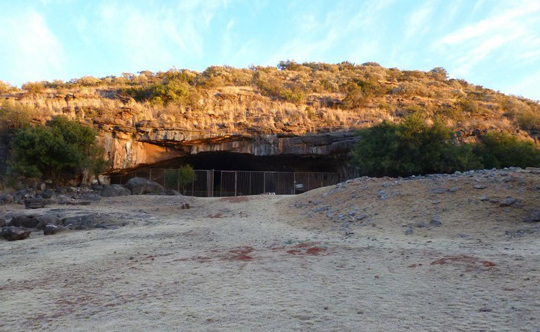Hominin Ancestors Had to Cope with Climate Change Too
It seems that climate change for hominins is not a new phenomenon, our ancient ancestors living in southern Africa almost two million years ago, had to cope with climate change too. A new study published in the academic journal “Nature Ecology and Evolution”, reveals that the climate of the interior of southern Africa during the Early Pleistocene (Gelasian stage), was like no modern African environment. The hominins around at the time would have had to cope with much wetter conditions.
The Entrance to the Wonderwerk Cave (Northern Cape Province)
Picture credit: Michaela Ecker/University of Toronto
The Wonderwerk Cave
That is the conclusion reached by an international team of scientists who conducted an analysis of the fossilised teeth of herbivores found in two-million-year-old sediments in South Africa’s Wonderwerk Cave. Lead author of the study, Michaela Ecker, a postdoctoral researcher in the University of Toronto’s Department of Anthropology, in collaboration with colleagues such as Michael Chazan the director of the University of Toronto’s Archaeology Centre, mapped the environmental change recorded in the sediments and fossils found in the Cave.
Commenting on the significance of the study, Michaela Ecker stated:
“The influence of climatic and environmental change on human evolution is largely understood from East African research. Our research constructed the first extensive palaeoenvironmental sequence for the interior of southern Africa using a combination of methods for environmental reconstruction at Wonderwerk Cave.”
A Different Climate to East Africa
While East African research shows increasing aridity and the spread of savannah (grassland habitats), this new research showed that during the same time period, southern Africa was significantly wetter and housed a plant community unlike any other in the modern African savannah. The scientists conclude that early humans were living in environments other than open, arid grasslands.
The Interior of Wonderwerk Cave

Picture credit: Michaela Ecker/University of Toronto
The limestone Wonderwerk Cave is located in the Kuruman Hills between Danielskuil and Kuruman in Northern Cape Province, the sediments deposited in the cave provide a palaeoenvironmental record of the climate of southern Africa. These sediments and the artefacts and fossils found within them have been studied since the 1940s.
Analysis of Cave Sediments
Analysis of the cave sediments to date has established a chronology for hominin occupation of the anterior portions of the cave stretching back two million years. In this research, Ecker and her collaborators were able to reconstruct the vegetation by using carbon and oxygen isotope analysis on the fossil teeth of herbivores found at various sediment layers within the cave.
Ecker added:
“Understanding the environment humans evolved in is key to improving our knowledge of our species and its development. Our work at Wonderwerk Cave demonstrates how humankind existed in multiple environmental contexts in the past, contexts which are substantially different from the environments of today.”
The scientists propose that Oldowan and early Acheulean lithic industries (distinctive periods of stone tool making), in this part of Africa took place in a much wetter environment than when compared to sites of showing similar stone tool cultures in eastern Africa.
The scientific paper: “The Palaeoecological Context of the Oldowan-Acheulean in Southern Africa” by Michaela Ecker, James S. Brink, Lloyd Rossouw, Michael Chazan, Liora K. Horwitz and Julia A. Lee-Thorp published in Nature Ecology and Evolution.
Everything Dinosaur acknowledges the help of a press release from the University of Toronto in the compilation of this article.
Visit the Everything Dinosaur website: Everything Dinosaur.







Leave A Comment